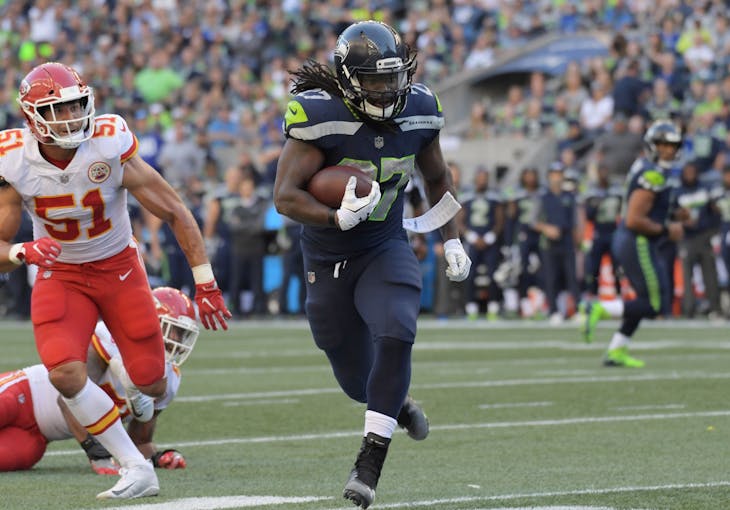
Much of fantasy football in-season owner strategy centers around which players to pick up from the waiver wire or to target in the trade market. However, roster spots are a premium resource. Cutting a player - or adding them to a trade - opens a roster spot for a key waiver wire addition or flexibility to keep a currently injured player through a missed game or two. Here are the key players to cut or trade after Week 1:
SHALLOW FORMATS
*15-18 roster spots*
Eddie Lacy (Trade on Name Value)
Why: There may be some market value left for Lacy among his most fervent supporters, but the Seattle offensive line struggled mightily against Green Bay and Chris Carson, C.J. Prosise, and soon Thomas Rawls will all limit Lacy's fading upside potential.
Why: The Jets will struggle to maintain a positive game script in most games this season. Forte has ceded passing game work to Bilal Powell and Forte looks to be eroding quickly on the physical front to win collisions and elude defenders.
Why: The Giants offensive line is one of the worst in the NFL and Orleans Darkwa and Shane Vereen will be heavily involved. Perkins offers minimal upside even with improved individual play as his 1A depth chart moniker is a mere placeholder than dominant snap share.
Why: Hill started the game but quickly gave way to a healthy Giovani Bernard and more talented rookie Joe Mixon for most snaps as the game progressed. Clearly not in the Bengals big picture plans, Hill offers little appeal in more shallow formats beyond a Mixon injury in the short term.
Allen Robinson
Why: Out for season with ACL
Why: Out for season with collarbone fracture
Why: On a middling pass game like Cleveland, the top receiving option is the lone wide receiver worth rostering in a shallow format. Deshone Kizer zeroed in on second-year option Corey Coleman often and Britt was a shadow in Week 1.
LaQuon Treadwell
Why: Treadwell saw some snaps as an outside receiver, but Minnesota is centric to Stefon Diggs, Adam Thielen, Kyle Rudolph, and Dalvin Cook in the pass game.
Eric Ebron (Shop)
Why: With a better receiver group than a year ago (adding Kenny Golladay) and plenty of production from the running back group through the air, Ebron's upside is squeezed to the occasional touchdown (now in question with Golladay seeing red zone work) or overt matchup. Seek an upgrade at another position by using Ebron as a throw-in.
MEDIUM DEPTH
*18-22 roster spots*
Why: The Bears were as bad as advertised through the air, relying on Jordan Howard and Tarik Cohen for any burst of promise on offense against Atlanta. Without Cameron Meredith and now Kevin White out for the season, Glennon - who is a fair-weather quarterback already - will deal with rainy conditions in terms of his perimeter weapons for the rest of the season.
Why: Colts mixed in rookie Marlon Mack liberally in Week 1 and Turbin appears as a low-upside safety blanket if Frank Gore misses time in the next few weeks. Mack would be firmly in the mix of a committee, at a minimum, squeezing Turbin's appeal as a final roster spot player in the meantime.
Why: Lewis will struggle to carve a role among the Patriots running back corps and has not looked the same since he recent bout with injuries - a commonality of his NFL career to-date. A trade could be the lone change to keep Lewis' life support fantasy stock alive for now, but seek better options off the wire in lieu of waiting out the possibility.
Why: A curious healthy scratch in Week 1, McFadden watched as Alfred Morris was the primary backup to Ezekiel Elliott who is in line to play through what was previously thought to be a six-game suspension to start the season. With a bevy of waiver options post-Week 1, McFadden is a cut in all but deeper leagues or with running back premiums.
Why: Gerald Everett saw a high number of snaps (45%) for his first NFL game and Higbee has done nothing to separate himself as the clear starter to-date in his career. With improvements at wide receiver, Higbee's upside is capped even with the starting role.
DEEP FORMATS
*25+ roster spots, more dynasty-focused*
Why: Even in quarterback premium formats, Savage is a drop recommendation. Houston lasted all but a half with Savage before inserting Deshaun Watson under center for a boost in the second half against Jacksonville. While there are bound to be rookie growing pains with Watson, he offers a playmaking ability with his mobility Savage does not.
Why: Patterson's main usage remained on manufactured touches and Seth Roberts was the more dependable WR3 in Oakland with an outstanding touchdown from Derek Carr. Patterson can be churned out heading into Week 2.
Why: Arizona's passing game is limited as Carson Palmer continues to erode and John Brown and J.J. Nelson both had quality showings in Week 1. Brown has been more depth than upside shot over the years sticking with the Cardinals roster.
Why: Coates was already a cut considering his status with Pittsburgh (or Cleveland) in the preseason. With his upside being WR4 in Cleveland this season, Coates is an easy cut recommendation.
Brandon Coleman
Why: The clock is ticking on Willie Snead's suspension return and Coleman was near invisible in Week 1. Unless Coleman is in your starting lineup Week 2 against the softer New England defense, cut him loose.
Why: Even in a game where George Kittle was limited during practices, the rookie saw 95% of snaps with Celek relegated to 25% and failing to see a target. Outside of the deepest of tight end premium leagues, move on for greener pastures.

_png)